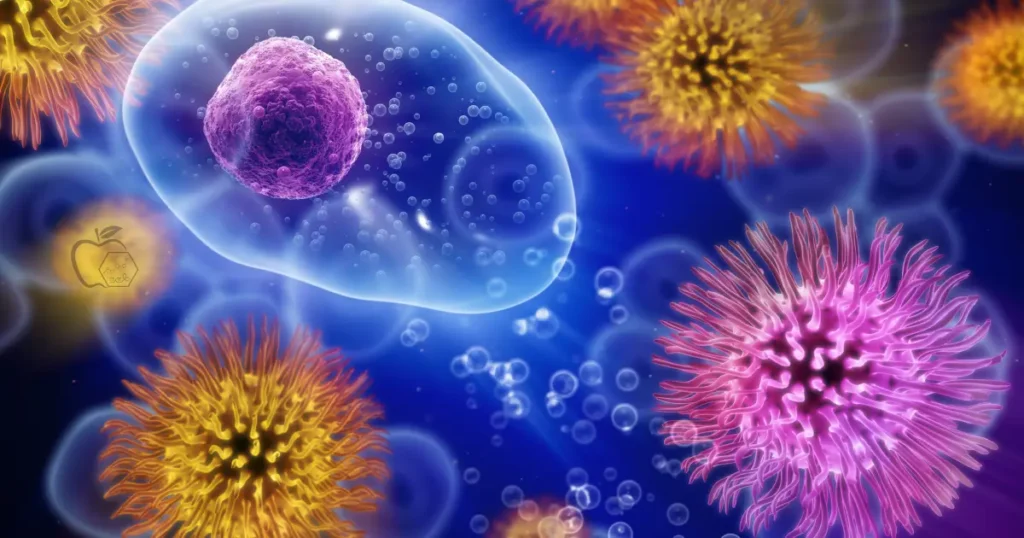Your cart is currently empty!
Can stress affect stem cells?
—
Stress, like feeling overwhelmed or anxious, can affect our body’s stem cells.
What are Stem Cells?
Stem cells play a crucial role in keeping us healthy. Whether repairing a scraped knee, regenerating skin after a sunburn, or even helping to grow new tissues and organs, stem cells are always on standby, ready to spring into action.
Their superpower lies in their ability to change into specialized cells, like muscle cells, skin cells, or even nerve cells.
This versatility makes them incredibly valuable for maintaining and repairing our body’s tissues and organs.
Understanding Stress
We all experience stress from time to time—it’s a natural part of being human.
Whether it’s a looming deadline, a challenging situation, or just the hustle and bustle of everyday life, our bodies are wired to react to stress.
When we encounter a stressful situation, our body kicks into gear, releasing hormones like cortisol, often called the “stress hormone.”
Cortisol acts like a signal to prepare our body for action, helping us to face whatever challenge lies ahead.
It’s like a built-in alarm system that alerts us to potential threats and prepares us to respond.

But when stress becomes chronic—lingering for weeks, months, or even years—it can start to take a toll on our health.
That’s when cortisol, our trusty stress hormone, can cause problems, disrupting the delicate balance within our bodies.
So, while a little stress here and there is normal and even necessary, too much of it can throw our body out of whack and have some unexpected consequences—including on our amazing stem cells.
The Impact of Stress on Stem Cells
Under normal conditions, stem cells play a crucial role in maintaining our body’s health by repairing damaged tissues and replacing old cells.

Too much cortisol can throw off the timing and effectiveness of our stem cells’ work, leaving our body’s repair mechanisms compromised.
In some cases, chronic stress can even cause our stem cells to become less responsive or stop working altogether.
This means that when our body needs them most—like after an injury or illness—our stem cells may not be as efficient at healing and regenerating tissues.
Effects on Health and Healing
The impact of stressed-out stem cells isn’t just a theoretical concern—it can have real consequences for our health and healing processes.
When our stem cells aren’t functioning at their best due to stress, it can slow down the repair and regeneration of our body’s tissues.
Compromised stem cell function can leave our body more vulnerable to illness and disease.

When they’re not operating at full capacity due to stress, it’s like leaving the front door unlocked—it makes it easier for harmful invaders to sneak in and wreak havoc.
Chronic stress has also been linked to a variety of health problems, including:
- cardiovascular disease,
- digestive issues, and even
- mental health disorders like depression and anxiety.
While the connection between stress, stem cells, and these health conditions is complex and multifaceted, it emphasizes the importance of taking steps to manage stress and support the health of our stem cells.
Managing Stress for Better Stem Cell Health
While we can’t always avoid stress entirely, there are steps we can take to manage it and support the health of our stem cells.

- Exercise:
- Physical activity is not only great for our overall health but can also help to reduce stress levels.
- Whether it’s going for a walk, hitting the gym, or practicing yoga, finding ways to move our bodies can have a positive impact on our mood and well-being.
- Mindfulness and Relaxation Techniques:
- Activities like meditation, deep breathing exercises, and progressive muscle relaxation can help to calm our mind and body, reducing stress and promoting relaxation.
- Taking just a few minutes each day to practice mindfulness can make a big difference in how we feel.
- Healthy Lifestyle Choices:
- Eating a balanced diet, getting enough sleep, and avoiding excessive alcohol and caffeine can all contribute to our body’s ability to handle stress.
- When we take care of our physical health, we’re better equipped to cope with life’s challenges.
- Social Support:
- Connecting with friends, family, and loved ones can provide valuable emotional support during times of stress.
- Whether it’s talking to someone about our feelings or simply enjoying quality time together, nurturing our relationships can help to buffer the effects of stress.
- Seeking Professional Help:
- If stress is significantly impacting our daily life and well-being, it’s important to reach out for help.
- A mental health professional can offer guidance and support tailored to our individual needs, helping us to develop effective coping strategies and manage stress more effectively.
By incorporating these strategies into our daily routine, we can take proactive steps to manage stress and support the health of our stem cells.
Conclusion
Taking care of our mental and emotional health is just as important as taking care of our physical health.
By prioritizing stress management and self-care, we can ensure that our body’s amazing repair system—the stem cells—can continue to work its magic and keep us healthy and thriving for years to come.
-
Fruita Cell (7s) 7-Day Trial Pack
₱1,225.00 -
RDB Fruita Cell (15s) 15-Day Trial Pack
₱2,600.00 -
RDB Fruita Cell (30s) Prime Package
Original price was: ₱5,200.00.₱4,888.00Current price is: ₱4,888.00.
References
- Chen, F., & Zhou, L. (2018). Exercise Interventions on Patients with Depressive Disorders: A Systematic Review and Meta-Analysis. International Journal of Environmental Research and Public Health, 15(2), 1–16. https://doi.org/10.3390/ijerph15020259
- Harvard Health Publishing. (2018). Understanding the stress response. Harvard Health. https://www.health.harvard.edu/staying-healthy/understanding-the-stress-response
- Jang, Y. C., & Sinha, M. (2019). YETI: A positive regulator of metabolic reprogramming and myogenesis in satellite cells. Nature Communications, 10(1), 1–11. https://doi.org/10.1038/s41467-019-11011-0
- Kiecolt-Glaser, J. K., McGuire, L., Robles, T. F., & Glaser, R. (2002). Emotions, Morbidity, and Mortality: New Perspectives from Psychoneuroimmunology. Annual Review of Psychology, 53(1), 83–107. https://doi.org/10.1146/annurev.psych.53.100901.135217
- Lai, L. H., & Fu, W. M. (2015). Hypoxia inducible factor-1α: A promising therapeutic target in autoimmune diseases. Autoimmunity Reviews, 14(6), 578–586. https://doi.org/10.1016/j.autrev.2015.02.003
- McEwen, B. S., & Gianaros, P. J. (2010). Central role of the brain in stress and adaptation: Links to socioeconomic status, health, and disease. Annals of the New York Academy of Sciences, 1186(1), 190–222. https://doi.org/10.1111/j.1749-6632.2009.05331.x
- National Institute of General Medical Sciences. (2021). The Ups and Downs of Cortisol: What You Need to Know. National Institute of General Medical Sciences. https://www.nigms.nih.gov/education/fact-sheets/Pages/cortisol.aspx
- Pariante, C. M., & Lightman, S. L. (2008). The HPA axis in major depression: classical theories and new developments. Trends in Neurosciences, 31(9), 464–468. https://doi.org/10.1016/j.tins.2008.06.006
- Pereira, M., Pfennig, P., & Passos, I. C. (2019). Exploring Metabolic Dysfunction in Bipolar Disorder: A Systematic Review of High-Throughput Metabolomics Studies. Journal of Proteome Research, 18(8), 2893–2903. https://doi.org/10.1021/acs.jproteome.9b00356
- Schillaci, G., Battista, F., Pucci, G., Avenoso, T., Porcellati, C., & Virdis, A. (2003). Usefulness of systolic function in predicting mortality in heart failure with normal ejection fraction. American Journal of Cardiology, 91(7), 929–931. https://doi.org/10.1016/S0002-9149(03)00012-1
- Seeman, T. E., & McEwen, B. S. (1996). Impact of social environment characteristics on neuroendocrine regulation. Psychosomatic Medicine, 58(5), 459–471. https://doi.org/10.1097/00006842-199609000-00001
- Slavich, G. M., & Irwin, M. R. (2014). From stress to inflammation and major depressive disorder: A social signal transduction theory of depression. Psychological Bulletin, 140(3), 774–815. https://doi.org/10.1037/a0035302
- Stoye, E. (2017). Stem cell transplant helps HIV patients live without anti-retroviral therapy. New Scientist. https://www.newscientist.com/article/2110783-stem-cell-transplant-helps-hiv-patients-live-without-anti-retroviral-therapy/
- Tavassoly, I., & Parmar, K. (2020). Stem Cells. In StatPearls. StatPearls Publishing. https://www.ncbi.nlm.nih.gov/books/NBK441868/
- Thaler, L., Gauvin, L., & Joober, R. (2013). Epigenetic mechanisms of schizophrenia. Canadian Journal of Psychiatry, 58(6), 260–266. https://doi.org/10.1177/070674371305800601
- Tuch, B. E. (2006). Stem cells—a clinical update. Australian Family Physician, 35(9), 719–722. https://www.racgp.org.au/afp/200609/10091
- Vargas, J. (2018). What Happens in the Body During Chronic Stress? American Psychological Association. https://www.apa.org/topics/stress-body
- Verstovsek, S., & Kantarjian, H. (2009). The role of cytokines in the progression of myelofibrosis. Clinical Lymphoma, Myeloma & Leukemia, 9(Suppl 1), S21–S26. https://doi.org/10.3816/clml.2009.s.001
- Wilson, A., Trumpp, A., & Fraser, S. T. (2006). Hematopoietic Stem Cells in Health and Disease. Cambridge University Press. https://doi.org/10.1017/CBO9780511545456
- Wolkowitz, O. M., & Reus, V. I. (1999). Stress hormone-related psychopathology: Pathophysiological and treatment implications. The World Journal of Biological Psychiatry, 1(3), 115–143. https://doi.org/10.3109/15622979909116322
Disclaimer
The information provided in this article is for educational and informational purposes only. It is not intended as medical advice or to replace the advice of a qualified healthcare professional. Readers should consult with a healthcare provider before making any decisions about their skincare, wellness, or dietary supplement regimens.



Leave a Reply